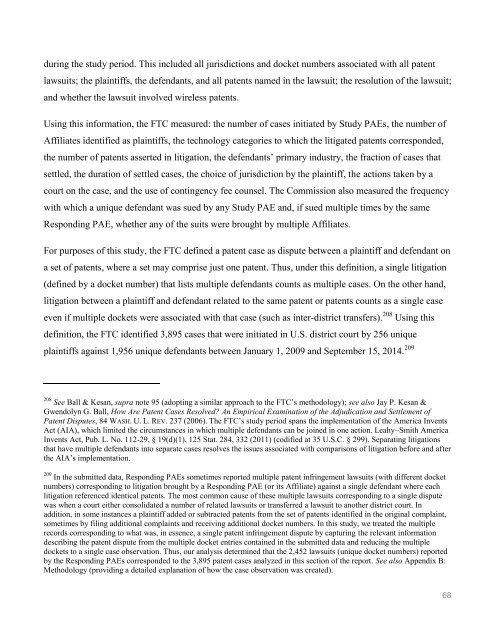Create successful ePaper yourself
Turn your PDF publications into a flip-book with our unique Google optimized e-Paper software.
during the study period. This included all jurisdictions and docket numbers associated with all patent<br />
lawsuits; the plaintiffs, the defendants, and all patents named in the lawsuit; the resolution of the lawsuit;<br />
and whether the lawsuit involved wireless patents.<br />
Using this information, the FTC measured: the number of cases initiated by Study PAEs, the number of<br />
Affiliates identified as plaintiffs, the technology categories to which the litigated patents corresponded,<br />
the number of patents asserted in litigation, the defendants’ primary industry, the fraction of cases that<br />
settled, the duration of settled cases, the choice of jurisdiction by the plaintiff, the actions taken by a<br />
court on the case, and the use of contingency fee counsel. The Commission also measured the frequency<br />
with which a unique defendant was sued by any Study PAE and, if sued multiple times by the same<br />
Responding PAE, whether any of the suits were brought by multiple Affiliates.<br />
For purposes of this study, the FTC defined a patent case as dispute between a plaintiff and defendant on<br />
a set of patents, where a set may comprise just one patent. Thus, under this definition, a single litigation<br />
(defined by a docket number) that lists multiple defendants counts as multiple cases. On the other hand,<br />
litigation between a plaintiff and defendant related to the same patent or patents counts as a single case<br />
even if multiple dockets were associated with that case (such as inter-district transfers). 208 Using this<br />
definition, the FTC identified 3,895 cases that were initiated in U.S. district court by 256 unique<br />
plaintiffs against 1,956 unique defendants between January 1, 2009 and September 15, 2014. 209<br />
208<br />
See Ball & Kesan, supra note 95 (adopting a similar approach to the FTC’s methodology); see also Jay P. Kesan &<br />
Gwendolyn G. Ball, How Are <strong>Patent</strong> Cases Resolved? An Empirical Examination of the Adjudication and Settlement of<br />
<strong>Patent</strong> Disputes, 84 WASH. U. L. REV. 237 (2006). The FTC’s study period spans the implementation of the America Invents<br />
Act (AIA), which limited the circumstances in which multiple defendants can be joined in one action. Leahy–Smith America<br />
Invents Act, Pub. L. No. 112-29, § 19(d)(1), 125 Stat. 284, 332 (2011) (codified at 35 U.S.C. § 299). Separating litigations<br />
that have multiple defendants into separate cases resolves the issues associated with comparisons of litigation before and after<br />
the AIA’s implementation.<br />
209<br />
In the submitted data, Responding PAEs sometimes reported multiple patent infringement lawsuits (with different docket<br />
numbers) corresponding to litigation brought by a Responding PAE (or its Affiliate) against a single defendant where each<br />
litigation referenced identical patents. The most common cause of these multiple lawsuits corresponding to a single dispute<br />
was when a court either consolidated a number of related lawsuits or transferred a lawsuit to another district court. In<br />
addition, in some instances a plaintiff added or subtracted patents from the set of patents identified in the original complaint,<br />
sometimes by filing additional complaints and receiving additional docket numbers. In this study, we treated the multiple<br />
records corresponding to what was, in essence, a single patent infringement dispute by capturing the relevant information<br />
describing the patent dispute from the multiple docket entries contained in the submitted data and reducing the multiple<br />
dockets to a single case observation. Thus, our analysis determined that the 2,452 lawsuits (unique docket numbers) reported<br />
by the Responding PAEs corresponded to the 3,895 patent cases analyzed in this section of the report. See also Appendix B:<br />
Methodology (providing a detailed explanation of how the case observation was created).<br />
68


